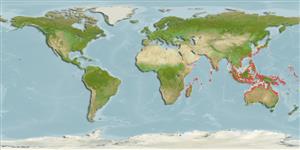Eucheuma arnoldii Weber-van Bosse
Mottled sea club| Native range | All suitable habitat | Point map | Year 2050 |

|
| This map was computer-generated and has not yet been reviewed. |
| Eucheuma arnoldii AquaMaps Data sources: GBIF OBIS |
Upload your photos
Google image |
No photo available for this species.No drawings available for Areschougiaceae.
Google image |
No photo available for this species.
Classification / Names Common names | Synonyms | CoL | ITIS | WoRMS
Florideophyceae | Gigartinales | Areschougiaceae
Environment: milieu / climate zone / depth range / distribution range Ecology
Sessile. Tropical
Distribution Countries | FAO areas | Ecosystems | Occurrences | Introductions
Indian Ocean: in Malaysia and Singapore; Pacific Ocean: in China and Japan, south to the South China Sea (Viet Nam and Philippines).
Length at first maturity / Size / Weight / Age
Maturity: Lm ? range ? - ? cm
Short description Morphology
Thalli form thick clumps, consisting of many clavate branches with slightly acute apices. Branches are densely covered with simple or compound spinose tubercles, regularly arranged into distinct nodes and internodes, forming verticils at the nodes; the verticils overlap at the distal portion of the branches so that the verticillate arrangement is obscured. Cross- section of a branch reveals a medulla composed of large rounded cells interspersed with smaller cells. Cortical cells very small, ovoid or elongated. Thalli up to 15 cm in height (Ref. 80758). It is easily mistaken for a live coral because of its close resemblance to corals of the genus Acropora (Ref. 80758).
Utilized for human consumption; a source of carrageenan (Ref. 80758). Grows on live corals, algal limestones or basalt substrates in close association with living hard and soft corals in lower intertidal to upper subtidal reef areas where the current is swift and the water free from silt (Ref. 80758)
Life cycle and mating behavior Maturity | Reproduction | Spawning | Eggs | Fecundity | Larvae
Main reference
References | Coordinator | Collaborators
Guiry, M.D. and G.M. Guiry. 2009. (Ref. 80701)
IUCN Red List Status (Ref. 130435)
CITES status (Ref. 108899)
Not Evaluated
CMS (Ref. 116361)
Not Evaluated
Threat to humans
Harmless (Ref. 80758)
Human uses
Fisheries: commercial
| FishSource |
Tools
More information
Internet sources
BHL | BOLD Systems | CISTI | DiscoverLife | FAO(Publication : search) | Fishipedia | GenBank (genome, nucleotide) | GloBI | Gomexsi | Google Books | Google Scholar | Google | PubMed | AlgaeBase | Tree of Life | Wikipedia (Go, Search) | Zoological Record
Estimates based on models
Preferred temperature
(Ref. 115969): 27.3 - 29.3, mean 28.7 (based on 1768 cells).


